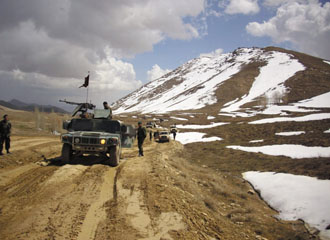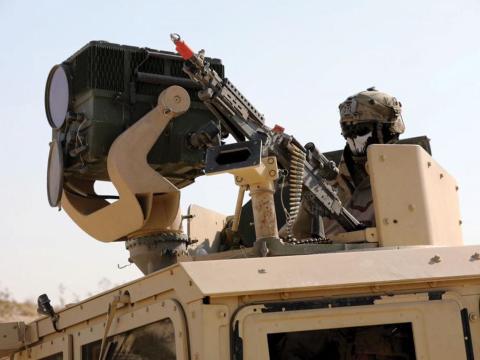 |
The Polish armed forces (PAF) are currently upgrading their command, control, communications, computers, intelligence, surveillance and reconnaissance (C4ISR) systems to better interoperate with NATO forces. Experience based on operations in Afghanistan has provided valuable lessons about coalition operations in an austere environment. |
National priorities focus on new technologies, information sharing with allied nations.
A key NATO nation on the alliance’s eastern flank is rapidly upgrading its computer and communications equipment to enhance interoperability with allied forces. Recent exercises and battlefield experience in Afghanistan have provided valuable lessons in establishing and managing networks in a coalition environment. This knowledge is being applied to the acquisition of new equipment, the creation of administrative and cyber security organizations and the adoption of alliance-wide policies for information assurance and data sharing.
Since joining NATO, Poland has worked to achieve compatibility between its own military services’ automated command, control, communications and intelligence (C3I) systems and those of alliance nations, explains Gen. Franciszek Gagor, PA, chief of the Polish armed forces (PAF) general staff. He notes that once Poland became a member of NATO, all information technology solutions adapted by the PAF now meet alliance standards. International exercises such as Combined Endeavour and the NATO Coalition Interoperability Warrior Demonstration also have proved the ability of Polish forces to interoperate with fellow NATO forces, he says.
However, meeting procedural requirements is more complicated, especially in specific areas such as protecting classified information and exchanging information between systems with different security levels. The general shares that different regulations among NATO and European Union member states, including rules only applying to forces directly participating in operations, are an additional complication delaying the goal of full interoperability. But the general stresses that despite these challenges the PAF steadily is becoming more network-centric.
The PAF is using network-centric capabilities to support forces at both the operational and strategic levels. At the tactical level, Gen. Gagor notes, the military places a high priority on providing the right amount of cutting-edge equipment to ground units and to personnel participating in international missions. He admits that some challenges remain in supporting strategic-level operations, mainly because of a limited supply of radio equipment available in the central Asian theater. The general says that it is important to remember that this equipment must have proper transfer speeds and appropriate encryption levels to meet information security requirements for this dynamic operational environment.
Poland’s military is taking a long-term, synchronized approach to upgrading its technology. The major phases in this process involve modernizing existing command and control systems and introducing new systems designed to produce more battlefield interoperability. According to Gen. Gagor, Poland’s priorities in this area include cooperating with countries that are leaders in NATO network-enabled capability/network-centric warfare (NNEC/NCW) capabilities. Poland will work primarily with NATO members to take advantage of concepts developed under the Allied Command Transformation’s Network Enabled Capability (NEC) Feasibility Study and NEC Strategic Framework. The general says that his second priority is to implement advanced national and allied technical solutions such as modern information technology nodes and broadband tactical Internet-protocol-based radios.
The government is emphasizing the development and fielding of Polish technologies and equipment; but in the areas where required capabilities are lacking, Poland will seek cooperation with allies. He shares that Polish solutions include high frequency radios, combat net radios, transmission shelters, information technology and radio access shelters. Areas where the Ministry of National Defense (MoND) is seeking allied cooperation include satellite communications, broadband Internet protocol radios, software-defined radios and special forces equipment.
The PAF currently use dozens of systems for C3I and for command, control, communications, computers and intelligence (C4I) operations. Gen. Gagor notes that the nation’s basic C3I systems were analyzed by NATO experts to assess their long-term viability. The systems were assessed positively at NNEC maturity levels of 2, 3 and 5. These levels measure the capability for conflict resolution and coordinated exploitation of C3I and information technology systems.
According to the general, Poland’s Minister of National Defense, Bogdan Klich, has approved several programs designed to achieve operational command, control, communications, computers, intelligence, surveillance and reconnaissance (C4ISR) capabilities in seven areas over the next decade. They include building up and integrating the MoND’s information technology network; providing network security and conducting cyber operations; procuring specialized systems to ensure the operational security of Polish forces in the field; procuring modern information technology services for the military; acquiring additional command and control support systems; integrating reconnaissance systems with command and control systems; and ensuring the standardization, synchronization and interoperability of military information technology systems and networks. The general adds that the Polish military also is striving to meet NATO force goals requirements fully.
As Poland modernizes and standardizes its C4ISR systems, major emphasis is being placed on developing tactical systems for all the armed services. However, each of the services has different requirements. Gen. Gagor notes that ground forces prioritize battlefield management systems, individual soldier networking and communications equipment and methods to support and ensure network functionality. Since the introduction of F-16 Fighting Falcons into the Polish air force, that service is focused on fielding a tactical data exchange system and providing an airborne command and control capability. The Polish navy is developing systems to facilitate interoperating with allied forces at sea. In other areas, a currently operational military-wide reconnaissance system is being upgraded with an image capture system. Poland also is acquiring unmanned aerial vehicles, and it is creating an intelligence analysis center to process the data.
Gen. Gagor explains that Poland’s acquisition and development plans are incorporated in the military’s Operational Programs and Force Goals document. Additionally, the MoND has launched an effort to replace old equipment and to provide network-centric capabilities to the army’s mechanized infantry battalions. The government also developed technical and tactical specifications to upgrade the army’s KTO Rosomak (Wolverine) armored personnel vehicles with command and control equipment and a range of personal Internet protocol radios for personnel. He adds that the upgrades to the personnel carriers are scheduled for procurement over the next few years.
Poland’s experience supporting International Security Assistance Force (ISAF) operations in Afghanistan is influencing current and planned modernization efforts. “It is in such missions and operations where we can best assess existing capabilities and equipment and draw the lessons for the future,” Gen. Gagor says. “Therefore, we carefully analyze the lessons learned from ISAF and do our utmost to translate them to future requirements and to incorporate them in our plans.”
Based on operational experiences in Afghanistan, Gen. Gagor relates, the most important challenge facing the Polish military is to provide its forces with proper levels of information security while facilitating interoperability between both national and allied units. A major requirement will be to develop an information management system that can operate in a multinational environment. The general adds that Polish forces will require battlefield identification and command and control systems such as the U.S. Army’s Blue Force Tracker and NATO identification friend or foe systems. In Afghanistan, Polish forces also operate the NATO ITFS friendly forces tracking system. He adds that combat vehicles leased to Poland from the U.S. military are equipped with FBCB2 system terminals.
One key operational challenge the PAF contingent in Afghanistan faces is operating and maintaining communications and information systems in such a remote and difficult region, Gen. Gagor shares. The computer information system currently used by the PAF uses very small aperture terminals (VSATs) to link units. The system ensures command and control, alerts and cooperation among Polish units in GhazniProvince as well as communication with national headquarters in Poland. The general says this system allows national information technology systems to connect to a classified digital communications subsystem, a classified information technology system, unclassified Internet access, the MoND network subsystem, an unclassified facsimile network, and national public telephone systems and mobile networks.
Poland also is procuring modern battlefield management systems for its forces. Gen. Gagor notes that the PAF initially assumed that a simplified version of its SZAFRAN-ZT command and control system would serve in the battlefield management role. However, one of the lessons learned in Afghanistan was the need for a fully mobile, efficient and interference-proof system that is fully integrated with other combat support subsystems. “It needs to work in real time and must be based on radio communication and be available at lower command levels,” he says.
In 2007, the Polish military began introducing the KTSAwp JASMIN mobile communications and networking platform, which will form the basis for a future battle management system. Gen. Gagor describes the JASMIN system as a modern, efficient Internet-protocol-based telecommunication system built in accordance with NATO standards. He says that it already has proved its usefulness and maturity in multinational exercises and in operations with ISAF. Likewise, operational experience with the SZAFRAN-ZT system indicates that it can be used effectively at the brigade and higher echelons.
In 2009 the technical and tactical specifications were produced for the new BMS/BFT battlefield management and monitoring system. Gen. Gagor says that the system will meet operational command and control needs from the battalion level down to individual soldiers. The first group of BMS/BFT systems is scheduled for acquisition this year.
To provide the enhanced network security required for network-centric operations, the Polish MoND has created the Computer Incidents Reaction System (CIRS). It consists of the CIRSCoordinationCenter, a military bureau tasked with providing communication and information technology security; the CIRSTechnicalSupportCenter; and administrators supporting classified and unclassified systems and computer networks in MoND units and organization cells. The CIRS counters incidents, reacts to them and manages security of the MoND’s systems and information technology networks. The CIRS also conducts training and cooperates with other organizations. Gen. Gagor notes that the current system ensures basic cyberdefense functions.
As part of its mission to protect MoND information technology systems, the CIRS has begun cooperating with the NATO Computer Incidents Reaction System. To enhance information security in cyberspace further, the CIRS will identify sources of computer incidents in cooperation with respective national authorities and exchange information with the NATOComputerIncidentResponseCenter and other allied countries.
WEB RESOURCE
Polish Ministry of National Defense: www.wp.mil.pl/en/index




